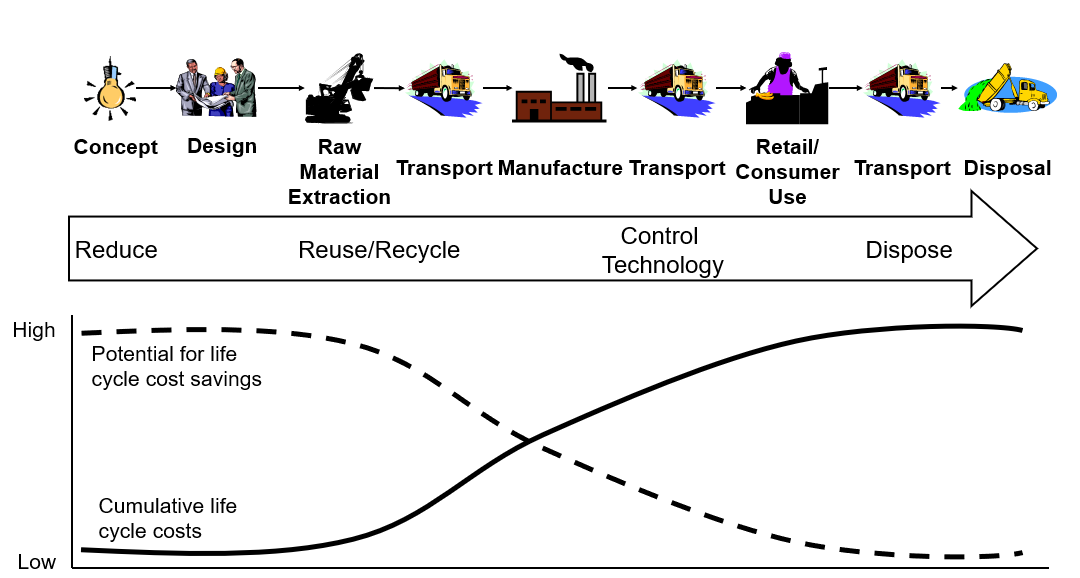Green Supply Chain improves operations by employing an environmental solution
•
Improves Agility—Green supply chain management help mitigate risks and speed
innovations.
•
Increases Adaptability—Green supply chain analysis often lead to innovative
processes and continuous improvements.
• Promotes Alignment—Green supply chain management involves negotiating policies with suppliers and customers, which results in better alignment of business processes and principles.
Green supply chain efforts need to rise above the cost center view
•
Green supply chain projects need to be clearly defined
in terms of the business value to the organization.
–
Clear value will gain senior management support.
–
Clear value will help secure buy-in from other
organizations
•
Environmental programs are viewed as business cost
centers.
–
Environmental, safety, and health (ESH) resources are
often scarce in an organization.
–
ESH offices are targeted early during cost cutting
programs.
•
ESH offices have difficulty articulating their
business value.
–
The inability to articulate the value of green supply
chain effort in business terms lowers their profile.
–
Many executives have misconceptions of how green
supply chain efforts will impact their operations.
–
Without a clear business value proposition, it is
difficult to get executive support for projects.
Consider the existing business model when planning GSC
projects.
•
Many businesses have internal hurdles that must be
overcome for any improvement effort.
–
Inconsistency in supply chain operations (by unit, region,
product, etc.)
–
Business viewed through existing operations—resistance
to change
–
Focus on short term goals and short-term results
–
Limited partnership experience—especially in the
environmental office.
•
To be successful, the project manager needs to
understand the organization and plan for the applicable hurdles.
–
Develop communication/evangelization plan.
–
Build a project team with broad functional
representation.
–
Clearly articulate project business value.
–
Use outside experts where in-house expertise doesn’t
exist.
Green supply chain best practices focus on the
business results first.
Green Supply Chain Best Practices
•
Align green supply chain goals with business goals
•
Evaluate the supply chain as a single life cycle
system
•
Use green supply chain analysis as a catalyst for
innovation
•
Focus on source reduction to reduce waste
Aligning GSC improvements with your business goals
creates strategic value.
•
Before embarking on green supply chain improvements,
you need to determine the role of the environment in your business.
–
Product Differentiation?
–
Managing Competitors?
–
Cost Reduction?
–
Risk Management?
–
Redefining Markets?
•
When green supply chain programs are properly aligned
to corporate goals, successes become leading indicators of business success.
–
Environmental indicators on the Balanced Scorecard
–
Greater drive for innovation
– Stakeholder support
Now, GSC programs are moving from compliance to value
creation
Environmental,
Safety, and Health Business Contributions
Traditional Cost Avoidance Emerging Value
Creation
Companies are starting to view GSC as a strategic
analysis tool
Evaluating the supply chain as a system leads to life
cycle optimization
System View of Environmental Life Cycle
Green supply chain management is a driver for process
improvements.
•
In general, pollution and waste represent incomplete,
ineffective, or inefficient use of raw material.
•
Green supply chain analysis provides an opportunity to
review processes, materials, and operational concepts.
•
As with continuous improvement programs, green supply
chain analysis targets:
–
Wasted material
–
Wasted energy or effort
– Under-utilized resources
Green Process Improvement Approach
![]() Identify the waste streams
Identify the waste streams
![]() Measure or identify the
opportunity cost of the waste
Measure or identify the
opportunity cost of the waste
Create innovation vs. treatment bias toward waste
reduction
Focusing on source reduction programs drives higher
value improvements
Waste Reduction Opportunities in the Life Cycle
Use tools such as Green SCOR to help define and
analyze GSC problems.
Green SCOR
Concept
 Green SCOR is a modification of the SCOR model that includes
environmental elements
Green SCOR is a modification of the SCOR model that includes
environmental elementsGreen SCOR Content
Implementing Green supply chain properly will drive real business value
•
Green supply chain concepts manage environmental
impacts where they occur—ideally before they occur.
•
Best practices focus on the business, not social,
value that green supply chain management creates.
–
Align green supply chain goals with business goals
–
Evaluate the supply chain as a single life cycle
system
–
Use environmental analysis as a catalyst for
innovation
–
Focus on source reduction to reduce waste
•
Successful implementation requires raising the profile
and perceived value of environmental projects.
–
Articulate project value in terms of business value
–
Create the project to work within the organizational
culture
–
Use effective tools (e.g., Green SCOR) to enable
project execution








.jpg)



%20(28).jpeg)

